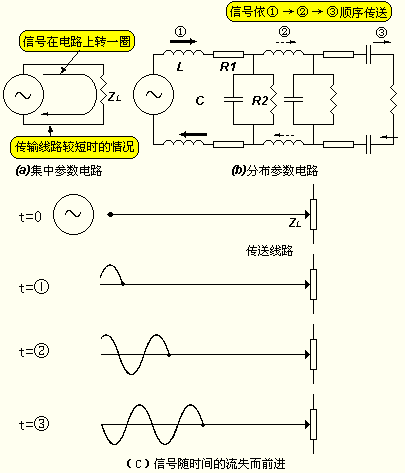Basic knowledge of high frequency circuits
|
|
|

|

|
| Figure 1-(a) Low frequency circuit | Figure 1-(b) High frequency circuit |
Figure (a) The low-frequency circuit is driven by a constant voltage. Even if the load impedance changes, the output voltage remains constant. The relationship between the amplifier's output impedance Zo and the load's impedance ZL is Zo|
The high-frequency circuit in Figure b is a power-driven circuit. The unit of the signal is power, and the most effective power that can be taken out of the load is when Zo=ZL, that is, when the impedance is matched (Impendance matting). Therefore, the consideration method for low-frequency circuit analysis is the same as that for high-frequency circuit analysis.
|
|
|
The figure on the right shows the analysis method of the concentrated constant circuit and the distributed constant circuit using the transmission path as an example.
|

Previous article:Overview of Oscillation Circuit
Next article:Half-wave synchronous detection circuit composed of switching circuit
- High signal-to-noise ratio MEMS microphone drives artificial intelligence interaction
- Advantages of using a differential-to-single-ended RF amplifier in a transmit signal chain design
- ON Semiconductor CEO Appears at Munich Electronica Show and Launches Treo Platform
- ON Semiconductor Launches Industry-Leading Analog and Mixed-Signal Platform
- Analog Devices ADAQ7767-1 μModule DAQ Solution for Rapid Development of Precision Data Acquisition Systems Now Available at Mouser
- Domestic high-precision, high-speed ADC chips are on the rise
- Microcontrollers that combine Hi-Fi, intelligence and USB multi-channel features – ushering in a new era of digital audio
- Using capacitive PGA, Naxin Micro launches high-precision multi-channel 24/16-bit Δ-Σ ADC
- Fully Differential Amplifier Provides High Voltage, Low Noise Signals for Precision Data Acquisition Signal Chain
- Innolux's intelligent steer-by-wire solution makes cars smarter and safer
- 8051 MCU - Parity Check
- How to efficiently balance the sensitivity of tactile sensing interfaces
- What should I do if the servo motor shakes? What causes the servo motor to shake quickly?
- 【Brushless Motor】Analysis of three-phase BLDC motor and sharing of two popular development boards
- Midea Industrial Technology's subsidiaries Clou Electronics and Hekang New Energy jointly appeared at the Munich Battery Energy Storage Exhibition and Solar Energy Exhibition
- Guoxin Sichen | Application of ferroelectric memory PB85RS2MC in power battery management, with a capacity of 2M
- Analysis of common faults of frequency converter
- In a head-on competition with Qualcomm, what kind of cockpit products has Intel come up with?
- Dalian Rongke's all-vanadium liquid flow battery energy storage equipment industrialization project has entered the sprint stage before production
- Allegro MicroSystems Introduces Advanced Magnetic and Inductive Position Sensing Solutions at Electronica 2024
- Car key in the left hand, liveness detection radar in the right hand, UWB is imperative for cars!
- After a decade of rapid development, domestic CIS has entered the market
- Aegis Dagger Battery + Thor EM-i Super Hybrid, Geely New Energy has thrown out two "king bombs"
- A brief discussion on functional safety - fault, error, and failure
- In the smart car 2.0 cycle, these core industry chains are facing major opportunities!
- The United States and Japan are developing new batteries. CATL faces challenges? How should China's new energy battery industry respond?
- Murata launches high-precision 6-axis inertial sensor for automobiles
- Ford patents pre-charge alarm to help save costs and respond to emergencies
- New real-time microcontroller system from Texas Instruments enables smarter processing in automotive and industrial applications
- Does the AD18 library have this kind of package? Do I have to draw it myself?
- 77Ghz single-chip millimeter wave sensor enables automatic parking
- What is the function of this circuit in ESP32_Audio_kit?
- Please ask about the problem in TI official application manual - boost principle
- TFT touch screen power supply problem
- STM32CubeMX uses LL library to set timer to control gpio flip
- What's the meaning of "Red umbrellas and white poles, lie down on the board together after eating"?
- 【Jiajiabao】 esp32s2 tcp+mqtt running
- I encountered several problems in the multisim simulation of the bandpass filter circuit, as shown in the figure. Which forum friend can give me some advice?
- No padsnet.err file is generated during synchronization. What is the reason?

 Signal Integrity and Power Integrity Analysis (Eric Bogatin)
Signal Integrity and Power Integrity Analysis (Eric Bogatin) 開關電源專業英語
開關電源專業英語
















 京公网安备 11010802033920号
京公网安备 11010802033920号